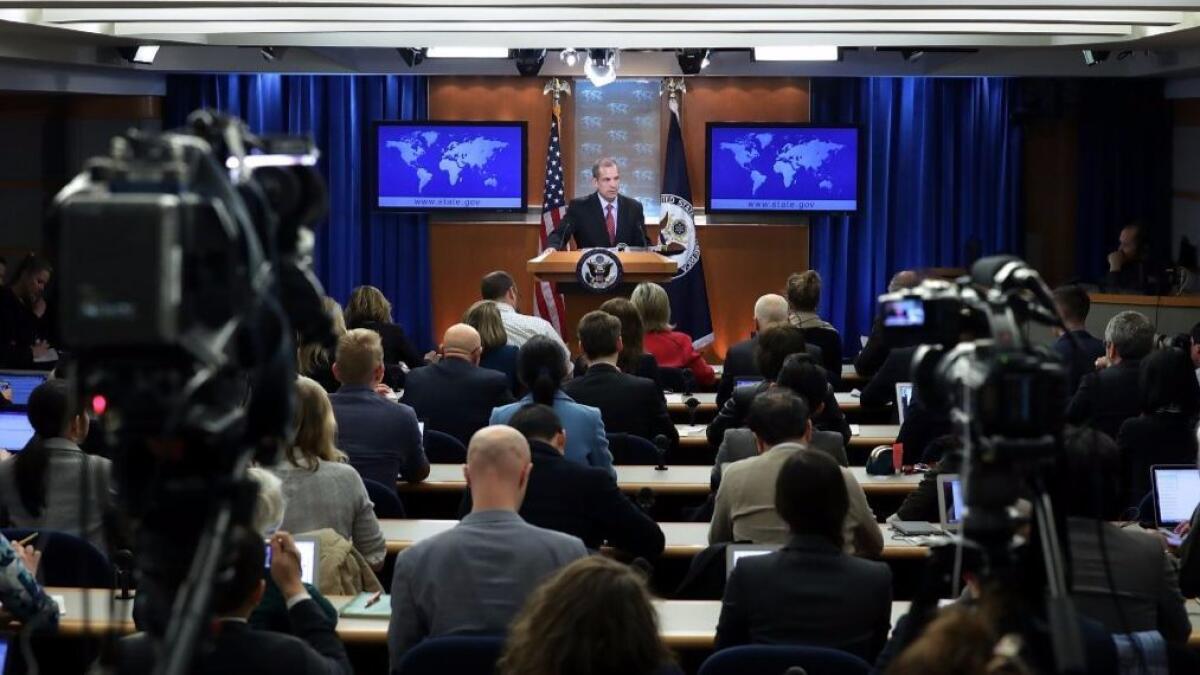‘Take a deep breath’: State Department holds first briefing since January and covers a lot of key issues

Reporting from Washington — People arrived early and saved seats. Walls of camera operators elbowed for position. It was an event anticipated from Capitol Hill to Embassy Row and especially here at Foggy Bottom.
After nearly a seven-week hiatus, on Tuesday the State Department finally held its first news briefing since President Trump took office.
For decades, foreign allies and adversaries alike had monitored the televised weekday briefings at the State Department as a core venue for the latest shifts and nuances in U.S. policy around the globe. The sessions were substantive if often dry.
But unlike his high-profile predecessors, Secretary of State Rex Tillerson has yet to grant any media interviews or hold his own news conference. He heads to Japan, South Korea and China next week and has declined to bring any reporters along, insisting the plane is too small.
His under-the-radar style has sent a message that he does not regard explaining the Trump administration’s foreign policy an important part of his job.
And so, the daily briefings were put on hold. Until now.
“Feels good to be back up here,” State Department spokesman Mark Toner, a holdover from the Obama administration, said as he plopped a thick loose-leaf notebook on a lectern.
More than 75 reporters, photographers and department aides packed the briefing room, a far larger than normal crowd.
They shouted questions and waved their hands. But compared with reporters at sometimes raucous briefings at the White House, the State Department media maintained decorum and parried respectfully with Toner, a veteran in the role.
Toner handled himself ably, never appearing flustered. He was quick to respond to whatever the topic, with varying degrees of answers useful to reporters seeking news.
To highlight the long absence, Associated Press reporter Matthew Lee asked the first question about scrutinizing aid for the Palestinians, an issue that was news back on Jan. 20, when Trump took office and the briefings were suspended.
Lee also made a small plea for the briefings, emphasizing their importance to explain the United States to the world.
Topics on Tuesday included deployment of U.S. defense systems in South Korea and ballistic missile launches by North Korea, the administration’s new travel ban against six mostly Muslim countries, and whether U.S. policy has changed on the Israeli-Palestinian conflict or the “one China” doctrine that recognizes Beijing as the sole Chinese power.
U.S. policy in some cases has been muddied after Trump seemed to suggest reversing long-standing U.S. positions.
The U.S. view of “one China” remains intact, Toner said, and “we are evaluating where we stand” on Israeli policy.
He was pressed to explain the administration’s travel ban, especially over why Iranian citizens — none of whom have been implicated in terrorism in the United States — should be punished for their government’s behavior.
Asked whether the State Department’s voice had been muffled in an administration that has upended traditional conduct of foreign policy, Toner offered up a defense.
“I assure you, the State Department voice has been heard, loud and clear,” at the White House and elsewhere, he said. He thanked journalists for patience as the administration “got its sea legs.”
Tillerson has yet to appoint a spokesperson, hence Toner’s continuation in the role. Scores of other high-level jobs at State are still open, however. Trump vetoed Tillerson’s choice for deputy, the aide who normally would carry much of the bureaucratic burden.
“Take a deep breath,” Toner said in response to questions about the unfilled positions, saying officials were working to vet and hire as quickly as possible. He also batted back queries about the possibility of deep budget cuts that could cripple the institution.
Because the department handles so many issues that were priorities under the Obama administration, including climate change, human rights and women’s equality, many at State fear those divisions will wither under Trump.
Secretaries of State normally fly on U.S. military aircraft or large chartered planes for overseas trips. Often a dozen or more journalists paid to go along and used the access to inform the public about meetings and negotiations.
Tillerson, however, brought only a handful of reporters on his first foreign trip last month, to the Group of 20 conference in Bonn and took only two journalists on an overnight trip to Mexico City on Feb. 23.
He is taking no accredited media on this trip to Asia next week, contending the plane is too small.
Media groups have protested, saying North Korea’s recent missile launches and growing nuclear program make coverage all the more important, and that’s nearly impossible to accomplish effectively without joining Tillerson’s entourage.
Tillerson has not asked for a bigger plane.
For more on international affairs, follow @TracyKWilkinson on Twitter
More to Read
Sign up for Essential California
The most important California stories and recommendations in your inbox every morning.
You may occasionally receive promotional content from the Los Angeles Times.











